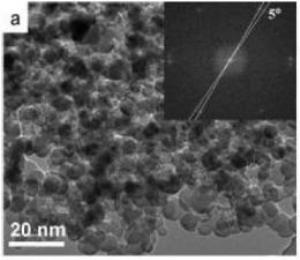The photovoltaic devices produced from organic materials provide several advantages over non-organic materials. Yet, the fabrication of organic photovoltaic devices involve expensive electron donor and acceptor materials. In a recent study, scientists have found a solution by blending luminescent graphene quantum dots (GQDs) with organic polymers that act as cost-saving electron acceptors.
Journal of the American Chemical Society, in its latest issue, has published a study done by research group, Dr. Vinay Gupta and coauthors from the Organic and Hybrid Solar Cell Group at the National Physical Laboratory located in New Delhi, India.
 A transmission electron microscopy image of the graphene quantum dots.
A transmission electron microscopy image of the graphene quantum dots.
According to researchers, several studies have been done in the past on quantum dots used as a material that accepts electrons in photovoltaics. The properties such as effective multiple carrier generation, size-based optical response, and cost-saving features make the quantum dots applicable for photovoltaic devices. Yet, researches conducted in the past reveals that several quantum dots are made up of toxic metals like lead and cadmium, which makes it unfit for applications in large-scale device.
On the contrary, researchers developed graphene quantum dots of 9 nm size that are different in nature and exhibit same electronic properties. Since graphene has a high-charge carrier generation it can rapidly carry charges to the electrodes ensuring minimum energy discharge and improvement in efficiency of the solar cell.
According to Gupta, GQDs display qualities of being a good acceptor and hence can replace costly C60-based acceptors. This discovery holds significance for effective and cost-saving solar cells and organic light-emitting diodes (OLEDs). Their major benefits include flexibility, less weight, large-scale processing, less expensive, roll to roll manufacturing, and multiple usages.
The scientists generated photovoltaic solar cells as well as OLEDs from GQD-based material, on the whole obtaining a better performance in the two devices.